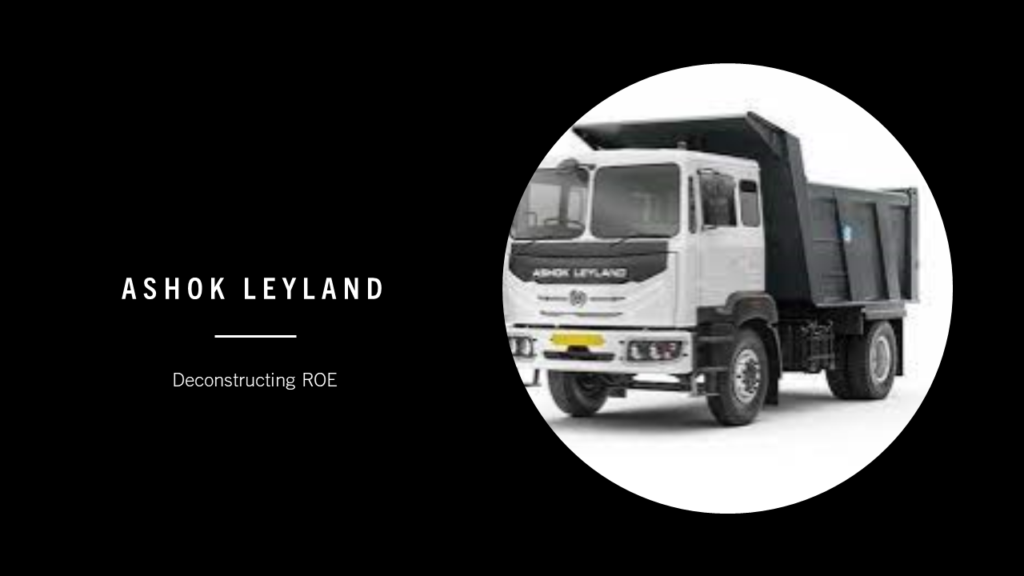It is extremely important not to allow your judgement to be biased by personal qualities. The emotional qualities are antagonistic to clear reasoning. I assure you that the most winning woman I ever knew was hanged for poisoning three little children for their insurance money and the most repellent man of my acquaintance is a philanthropist who has spent nearly a quarter of million upon the London poor.
This is not only true for people, but also for companies like Ashok Leyland (one of the largest commercial vehicle manufacturers in the country) with an average Return on Equity (ROE) of 15% in the last 5 financial years.
Now, this ROE seems to be high, let’s try and deconstruct the formula of ROE
ROE = Net Profit Margin represented by Net Income / Sales X Sales Turnover represented by Sales / Assets X Leverage represented by Assets / Equity
To raise ROE, companies would require at least one of the following:
1. Wider net margin
2. Lower income taxes
3. An increase in turnover (i.e. ratio between sales and total assets employed in the business)
4. More leverage
5. Cheaper leverage
There simply are no other ways to increase returns on common equity.
Let’s look at each of these one by one.
Net Margin: The company’s average net profit margin (net income/Net Sales) for the last 5 years was ~4%. While Net sales has declined by 20% since FY2017 to INR 19,754 crs, primarily on account of Covid and demand plummeting. With increasing intensity of competition in the industry, increasing margins consistently is almost an impossibility.
Income Taxes: While Benjamin Franklin has aptly said: In this world nothing can be said to be certain, except death and taxes. This clearly sums up the income tax rates, which clearly are not moving anywhere. At least chances of going down is remote. Ashok Leyland’s effective tax rate has fluctuated between ~3% in 2021 to 38% in 2020.
Turnover: There are three major categories of assets which one needs to think about when looking at Turnover: Accounts Receivable, Inventories and Fixed assets such as Property, Plant & Equipment.
Accounts Receivable move generally in tandem with Sales, i.e., will generally increase as Sales increase. Inventories on the other hand are usually valued at cost or net realizable value, thereby resulting in conservative inventory asset values.
While increase in prices immediately get reflected in Sales, Fixed Assets will reflect the change only gradually, i.e. as existing assets are retired and replaced at the new prices. Obviously, the more slowly the company goes about the replacement process, the more turnover ratio will rise. The action stops, however, when a replacement cycle is completed. With Sales having plummeted by 20% in the last 5 years, Total Assets have however increased by ~58% during this period. Sales / Total Assets of the company over the last 5 years has declined from 0.9x in FY17 to 0.5x in FY21.
Now, with the above components, Net Margin of 4% and Average Sales Turnover of 0.8x, the only component now remains is Leverage in the remaining equation. With Leverage (Assets / Equity) of ~ 4.8x in the last 5 years, the company’s average ROE for the last 5 stands at ~15%, i.e., Net Profit Margin of 4.2% X Average Sales Turnover of 0.8x X Leverage or Equity Multiplier of 4.8x
However, one needs to understand that more leverage and lower rates are unlikely to go together. In fact, higher the leverage, chances of rates increasing becomes higher. Also, increasing leverage is only a panacea for higher risk.
So, next time, someone talks about a high ROE, you know appearances can be deceiving!!
Please note that these are my personal views. Request you to conduct your own independent research or consult your financial advisor before investing.
Hope you enjoyed listening to this!!
For more interesting topics, you may check out my website, www.jaagrav.com. If you want to reach out to me, you may email me at vikas@jaagrav.com
Thanks!

